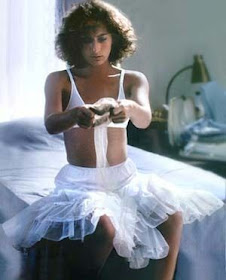======
The Coming-of-Age genre includes the Ugly-Duckling genre. The protagonist matures physically from an homely, awkward child into a beautiful, graceful adult. The physical maturation symbolizes an overall maturation that includes adult self-acceptance and self-confidence.
 |
| An immature swan and a mature swan |
 |
| Megan Fox as a child and as an adult |
 |
| Ryan Seacrest as a child and as an adult |
 |
| Baby dressed and groomed boyish |
 |
| Baby still dressed boyish |
 |
| Baby becoming womanish |
 |
| Baby dressing for the movie's final scene |
======
Another feature of the Ugly Duckling genre is the protagonist's feeling of being shunned. More than feeling just different from her parents, siblings and peers, the protagonist feels also rejected by them. This genre feature too appears in Dirty Dancing.
After Baby's father learns that she used his money to pay for an illegal abortion, he tells her:
You're not the person I thought you were, Baby. I'm not sure who you are.In the Ugly Duckling genre, the duckling's supposed father gradually recognizes that he is not the duckling's real father and therefore rejects the duckling. Baby feels that she is being rejected likewise by her father and even by her entire family.
I'm in this family too, and you can't keep giving me the silent treatment.Baby's curly, unruly hair differs from the straight, coifured hair of her mother and sister. In one scene, sister Lisa begins to adjust Baby's hair but then immediately gives up.
I’ll do your hair. It could look pretty if ... You're prettier your way -- this way.
 |
| Sister trying to deal with Ugly Duckling's weird feathers |
Another feature of the Ugly Duckling genre is that the protagonist secludes herself for a while, pondering her different nature. This pondering results in her self-acceptance.
 |
| The Ugly Duckling pondering about her being different |
The ugly duckling, because of its odd looks, is often abused, neglected, disregarded and scorned by the society.==========
The ugly duckling, hurled by the salvo of abuses, decides to leave the society, to live in the forest.
In the forest, the duckling leads a lonely, meditative and beautiful life, without abuse or scorn or fear from the society.
After some years, the ugly duckling grows into a beautiful swan, much admired by its new companions.
The story ends with the transformation of the ugly duckling into a beautiful swan. ....
Spiritual context:
The ugly duckling paints a beautiful part of our nature which is contrary to the conventional identity that we have assumed ourselves or what the society has given us. Often that which is ugly turns out to be beautiful. This story shatters all conventions of the society. The story is one of human growth and maturity.
Men are often engrossed by their identities, in the form of looks, social strata etc., which the society labels on them. They are piled by the miseries and the sufferings, which the society puts on them. Men are akin to this ugly duckling, often cited for their ugliness and miserable looks.
Men often think that the social life is the only life that exists. But there is another side of the life, where the goals and ideals are contrary to the social conventions. As men enter the other side of this life, a great peace dawns on them, far removed from the chaos of the society. This is the life similar to that of the ugly duckling, a lonely, meditative and beautiful life, far removed from the abuses of the society.
Men, after a prolonged series of meditative life, transform themselves into something larger than life, just as the ugly duckling transforms itself into a beautiful swan. This is the transformation, which nothing can alter, which nothing can disturb, and which is permanent. Men then become majestic like the beautiful swan in the ugly duckling. Men experience great joy and peace-infinite with this transformation.
Men in their lives carry the so-called tag of social identity, which is far removed from the real identity. A man has to pause for a while to find out his real identity, to seek redemption, peace and joy.
The Story Behind the Ugly Duckling
The Ugly Duckling (Character)
The Ugly Duckling, by Hans Christian Andersen
==========
======
I will conclude this series in Part 8.
No comments:
Post a Comment